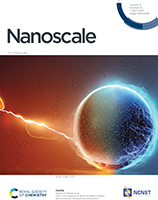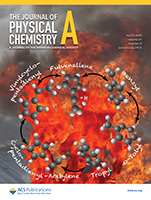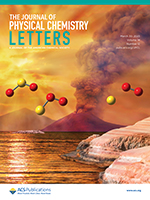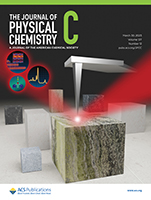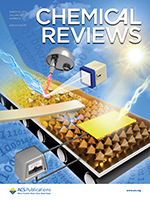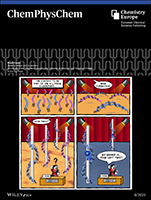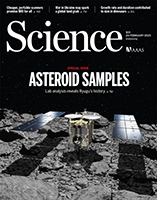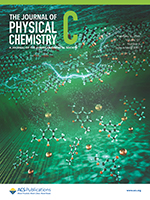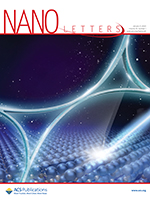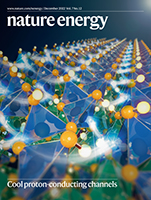We report, for the first time, sub-4 nm mapping of donor : acceptor nanoparticle composition in eco-friendly colloidal dispersions for organic electronics. This technology shows great promise for the optimization of organic semiconductor blends for organic electronics and photocatalysis and has further applications in organic core–shell nanomedicines. Read more »
Journal Covers
The Identity and Chemistry of C7H7 Radicals Observed during Soot Formation
Recent work suggests that resonance-stabilized radicals may participate in chain reactions that lead to soot-particle formation, but their identities and chemistry are poorly understood. C7H7 is often observed in aerosol mass spectra and is generally assumed to be benzyl, the most thermodynamically stable C7H7 isomer. It has now been shown that the identities of these isomers are far more varied, and their chemistry is far more complex, than previously appreciated. Read more »
SO2 Photodissociation at 193 nm Directly Forms S(3P) + O2(3Σg–): Implications for the Archean Atmosphere on Earth
Sulfur isotope patterns in ancient rock layers inform our understanding of Earth’s Archean atmosphere. Before the Great Oxygenation Event (~2.4 billion years ago), hard ultraviolet light penetrated into the Earth’s surface, photodissociating sulfur dioxide directly to S + O2. This new product channel may help resolve discrepancies in the Earth’s evolutionary history. Read more »
Raman and Far-Infrared Synchrotron Nanospectroscopy of Layered Crystalline Talc: Vibrational Properties, Interlayer Coupling, and Symmetry Crossover
Talc is an electrical insulator and an excellent target for low-cost, heterostructure-based optoelectronic applications. Here, light-matter interactions and their consequences at the nanoscale-thickness limit are probed using Raman spectroscopy, near-field synchrotron infrared nanospectroscopy, and first-principles calculations. Read more »
In Situ and Operando Characterizations of Metal Halide Perovskite and Solar Cells: Insights from Lab-Sized Devices to Upscaling Processes
The performance and stability of metal halide perovskite solar cells strongly depend on precursor materials and deposition methods adopted during the perovskite layer preparation. This review presents an update of studies conducted in situ using a wide range of structural, imaging, and spectroscopic techniques, involving the formation/degradation of halide perovskites. Read more »
Intrinsically Chiral Twist-Bend Nematogens: Interplay of Molecular and Structural Chirality in the NTB Phase
Cartoon depiction of the formation of the heliconical chiral twist-bend nematic phase (N*TB) from its constituent bent molecules. The presence of a single enantiomer of the chiral, lactate-based liquid crystal dimers biases the formation of helices with only one handedness, unlike in the conventional NTB phase, observed for achiral molecules, for which the left- and right-handed helices are doubly degenerate. Read more »
Macromolecular organic matter in samples of the asteroid (162173) Ryugu
We investigated the macromolecular organic matter in samples of the asteroid Ryugu—brought to Earth by the Hayabusa2 spacecraft—measuring its elemental, isotopic, and functional group compositions along with its small-scale structures and morphologies. Analytical methods used included spectro-microscopies, electron microscopy, and isotopic microscopy. Read more »
A Study on the Reaction Mechanism of a Model Organic Cathode in Magnesium-Ion Batteries
Battery and analytical studies of a model benzoquinone-type cathode reveal reversible structural transformations driven by a new precedence of a unique dissolution/precipitation mechanism and raise the question regarding its prevalence in other organic cathode batteries. Read more »
Dirac Nodal Line in Hourglass Semimetal Nb3SiTe6
Hourglass fermion in an electronic band structure is protected by the nonsymmorphic symmetry of a layered semimetal Nb3SiTe6. Angle-resolved photoemission spectroscopy demonstrates the band features of an hourglass fermion in k-space, such as band crossings and nodal loops. Read more »
Enhanced low-temperature proton conductivity in hydrogen-intercalated brownmillerite oxide
Solid oxide materials typically need high temperatures to allow appreciable ion transport, limiting their flexibility as electrolytes for energy devices. Lu et al. now show unusually high proton conductivity in a hydrogenated oxide between 40 °C and 140 °C, which they attribute to ordered vacancy channels and high proton concentrations. Read more »
- « Previous Page
- 1
- 2
- 3
- 4
- 5
- …
- 18
- Next Page »
